The new Apple Silicon-based Mac mini is an entry point into Apple's new processor ecosystem, but here's how exactly it compares to the old Intel-based model.
One of the things that Apple Silicon will have to do is to draw developers and users to the platform, and one way it can accomplish that is by offering itself as a reasonably-priced computing option. For many people needing a desktop-based Mac replacement or switching from Windows-based PCs, that option largely boiled down to the Mac mini.
Now Apple has increased the performance of the Mac mini by reworking it with an Apple Silicon M1 processor. And it's also lowered the entry-level price by $100.
As the smallest Mac Apple sells in terms of stature, as well as in pricing, the Mac mini is an attractive proposition, and one that can easily slot in to a user's existing computing environment if they are upgrading from an older model, or from a PC. It makes sense for one of Apple's first forays into Apple Silicon to be one that follows a similar path.
In fact, there has already been one Apple Silicon Mac mini in existence. The Developer Transition Kit Apple supplied to developers after WWDC effectively consisted of a Mac mini with a different processor inside, with the internals and rear panel switched out for different versions while keeping the same enclosure.
At the time, it was warned that the Developer Transition Kit would give hints for what to expect from the full-fat Apple Silicon experience, but production hardware would most probably change before its release.
Now, with the announcement of an Apple Silicon version, the first real comparisons can be made with the outgoing Intel model. We'll have to see what results we get from AppleInsider's real-world testing, but for now, Apple's specifications tell us a huge amount.
Apple Silicon Mac mini versus Intel Mac Mini - Specifications
| Mac mini (Apple Silicon 2020) | Mac mini (Intel 2018) | |
|---|---|---|
| Starting price | $699 Lowest Apple Silicon Mac mini prices | $799 Lowest Intel Mac mini prices |
| Dimensions (inches) | 1.4 x 7.7 x 7.7 | 1.4 x 7.7 x 7.7 |
| Weight (pounds) | 2.6 | 2.9 |
| Processor | Apple M1 8-core CPU | 8th-generation 3.6GHz 4-core Intel Core i3 8th-generation 3.0GHz 6-core Intel Core i5 8th-generation 3.2GHz 6-core Intel Core i7 |
| Graphics | 8-core GPU | Intel UHD Graphics 630 |
| RAM | 8GB, 16GB | 8GB, 16GB, 32GB, 64GB |
| Networking | 802.11ax Wi-Fi 6 wireless networking IEEE 802.11a/b/g/n/ac compatible, Bluetooth 5.0 wireless technology, 10/100/1000BASE-T Gigabit Ethernet | 802.11ac Wi-Fi Bluetooth 5.0 Gigabit Ethernet Optional 10Gb Ethernet |
| Storage | 256GB, 512GB, 1TB, 2TB | 256GB (Core i3 and Core i7), 512GB, 1TB, 2TB |
| Display | None | None |
| Ports | HDMI 2.0, two USB 4/Thunderbolt 3, two USB-A, Ethernet, 3.5mm headphone | HDMI 2.0 Two USB 3 ports, Four Thunderbolt 3 ports, Ethernet, 3.5mm headphone |
Apple Silicon Mac mini versus Intel Mac Mini - External appearance
The physical shape of the chassis may be more important with the Mac mini than in any other Mac. That's because while this devices works as an entry-level Mac for very many users, it's also routinely used in arrays where hundreds or even thousands of Mac mini machines are racked together.
Perhaps because of that, the Mac mini has largely kept the same general appearance over the years, and the new model retains exactly the same square and relatively thin lump of aluminium. It's fractionally lighter, though, at 2.6lbs instead of the 2018 Intel Mac mini's 2.9lbs.
The low-profile Mac, measuring 7.7 inches square and 1.4 inches thick, has rounded corners and bears the Apple logo on the top. All of the ports and connections are routed through the back panel of the Mac mini, leaving a quite polished and stark presence on the desktop.
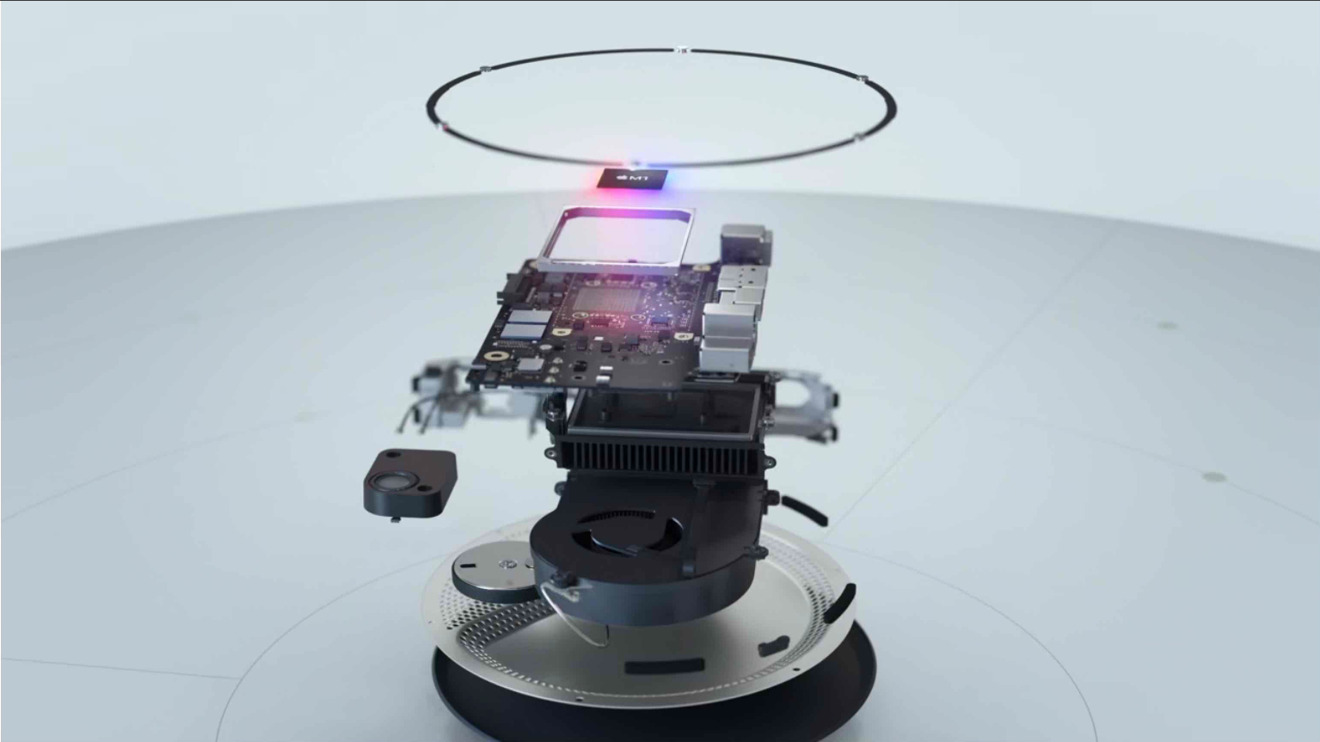 This exploded view may be your only chance to see the insides of the new Mac mini as you can no longer open it to upgrade RAM
This exploded view may be your only chance to see the insides of the new Mac mini as you can no longer open it to upgrade RAMApple Silicon Mac mini versus Intel Mac Mini - Processors and memory
Apple offers the Mac mini with a choice of three Intel processors, with the base configuration consisting of an 8th-generation quad-core Intel Core i3. The Intel Core i3-8100B is clocked at 3.6GHz, but is unusual in the range that it doesn't include support for Turbo Boost or Hyperthreading, meaning the clock speed won't get any higher than that.
The middle-chip in the range is the Intel Core i5-8500B, a six-core chip with a base clock of 3GHz and a maximum clock sped of 4.1GHz under Turbo Boost, though it is limited to six threads due to a lack of Hyperthreading support. At the top end is the Intel Core i7-8700B, a six-core chip that supports both Turbo Boost and Hyperthreading, meaning it can generate 12 threads and can raise its clock speed from 3.2GHz to 4.6GHz.
The shared L3 cache starts from 6MB on the Core i3, rising to 9MB in the Core i5, then to 12MB in the Core i7.
In terms of memory, the Mac mini ships with a base configuration of 8GB, but that can be upgraded to 16GB, 32GB, or 64GB. Apple uses 2,666MHz DDR4 SO-DIMM memory in the Mac mini.
Where the 2018 Intel model offered three different processors, the new Mac mini with Apple Silicon M1 comes with just a single option, at least in this first release. It's perhaps not surprising that Apple has not come out with multiple versions for its initial release, but there are differences in the M1 processor used in other Apple Silicon devices.
The MacBook Air with Apple Silicon, for example, comes with an option that includes either a 7-core GPU or an 8-core one. The Mac mini offers solely the 8-core GPU, alongside the 8-core CPU, and the 16-core Neural engine.
Apple does not offer a point by point comparison between processors, preferring only to state that the CPU in the M1 is up to three times faster than the previous generation. For graphics, Apple says the new Mac mini is up to six times faster than its predecessor.
In terms of memory, the new Mac mini still ships with the same base configuration of 8GB, but that can be upgraded at time of order to 16GB. Apple previously used 2,666MHz DDR4 SO-DIMM memory in the Intel Mac mini, and also offered it in 32GB and 64GB configurations.
Now the RAM is what Apple calls unified memory, which it says provides faster performance. However, the RAM in the Mac mini is no longer upgradeable after purchase, which is a significant difference.
Apple Silicon Mac mini versus Intel Mac Mini - Comparing processor performance
According to Geekbench, the Intel Core i3-8100B achieves a single-core score of 972 points and a score of 3,351 for multi-core testing. The Core i5-8500B is reported as having scores of 1,055 for single-core and 4,659 for multi-core, and the Core i7-8700B offers respective scores of 1,167 and 5,694.
Initial results for the M1 in the MacBook Air reveal it to have Geekbench scores in the ballpark of 1,730 for the single-core testing and 7,500 for multi-core versions, with little likely deviation for the Mac mini once it undergoes benchmarking itself.
This indicates the M1 is a far more capable chip than even the highest-powered version offered in the old Mac mini. It will likely fare power users better than the MacBook Air too, as the Mac mini offers better thermal management in the form of a fan for cooling.
Apple Silicon Mac mini versus Intel Mac Mini - Graphics
The Mac mini relies on Intel UHD Graphics 630, the graphics processing unit integrated into the processors. Given the small size of the Mac mini's enclosure, there's no real option for Apple to include a traditional discrete graphics option, in the device, so, Apple has opted to use its own GPU design and include it in the M1 processor.
According to the GFXBench 5.0 results browser, Intel UHD Graphics 630 for desktop processors scores 1,454 onscreen frames in the Aztec Ruins Normal Tier, and 834 on the High Tier variant. By contrast, the Apple M1 manages 3,859 frames and 3,492 frames respectively, giving it a considerably comfortable lead over its predecessor.
Apple Silicon Mac mini versus Intel Mac Mini - Connectivity
The old Mac mini offers a plethora of rear connections, starting with a quartet of Thunderbolt 3 ports, as well as a pair of USB-A 3.0 ports, an HDMI 2.0 output, and a 3.5mm headphone jack.
On the networking side, it also offers 802.11ac Wi-Fi and Bluetooth 5.0 support for wireless connectivity, as well as Gigabit Ethernet for physical networking. Apple also includes an optional upgrade for 10Gbps Ethernet.
The new Mac mini with Apple Silicon M1 matches most of this — and beats some of it. It provides the faster Wi-Fi 6, or 802.11ax, for example, plus Thunderbolt/USB 4 ports.
Where it arguably falls down is in the number of ports. The new Mac mini has only two USB 4 ports with support for Thunderbolt 3 instead of four Thunderbolt 3 with USB support. It does, though, come with two USB-A ports.
Apple Silicon Mac mini versus Intel Mac Mini - Storage
Apple again offers the Mac mini starting with a storage option of a 256GB SSD in one base configuration, with upgrades to 512GB, 1TB, and 2TB of storage. The other configuration starts from 512GB and has the same 1TB and 2TB options.
This effectively boils down to both configurations having the same 256GB to 2TB storage capacity range. The previous Intel Mac mini had different options, with the Core i3 and Core i7 versions able to be configured to have 256GB of storage.
Apple Silicon Mac mini versus Intel Mac Mini - User upgradability
Upgrading the Mac mini has changed over the years, and not always for the better. While earlier models allowed users to change the storage drive for a higher capacity, or to move from mechanical hard drives to SSDs, the new Mac mini with Apple Silicon M1 removes even the ability to upgrade the RAM.
Apple has traditionally always priced RAM far higher than other suppliers, so the ability to add more after purchase was significant in making the Mac mini affordable. That ability to add RAM later also meant that users could keep improving the performance of their machine as it aged.
Apple Silicon Mac mini versus Intel Mac Mini - Pricing
Apple starts the new Mac mini with Apple Silicon M1 at $699 in the lowest-priced configuration. This gets you 8GB RAM and 256GB storage. Upgrading to the now maximum 16GB adds $200 to the price.
Similarly, moving up from the base 256GB to 512GB also takes $200. The 1TB version is yet another $200. Going from the base 256GB all the way up to 2TB storage adds $800 to the price.
Comparing Apple with Intel
The new Mac mini is far faster than the old Intel model. Unusually for Apple, it's also actually cheaper. That combination, especially the extremely improved performance, is enough to show just why Apple has made the move to Apple Silicon.
There is the issue that you can no longer upgrade the RAM in the Mac mini. That means it's probably a better bet, in the long term, to spend $899 and buy the version with the most RAM already installed.
Whether you do that or not, though, in every way that we can yet measure, the new Mac mini is an extremely substantial upgrade to the old one.
Update: November 14 3:00pm ET - Added data on initial benchmark results for the M1.
Keep up with AppleInsider by downloading the AppleInsider app for iOS, and follow us on YouTube, Twitter @appleinsider and Facebook for live, late-breaking coverage. You can also check out our official Instagram account for exclusive photos.
 Malcolm Owen
Malcolm Owen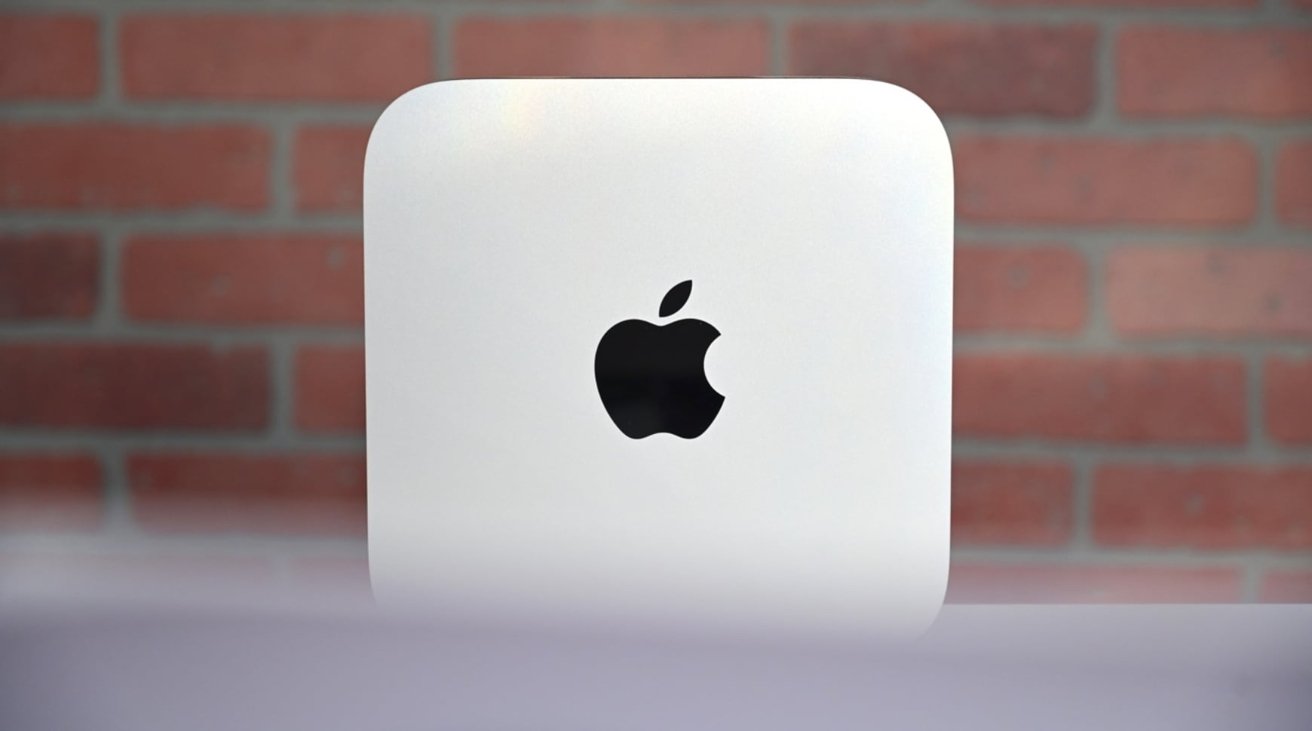
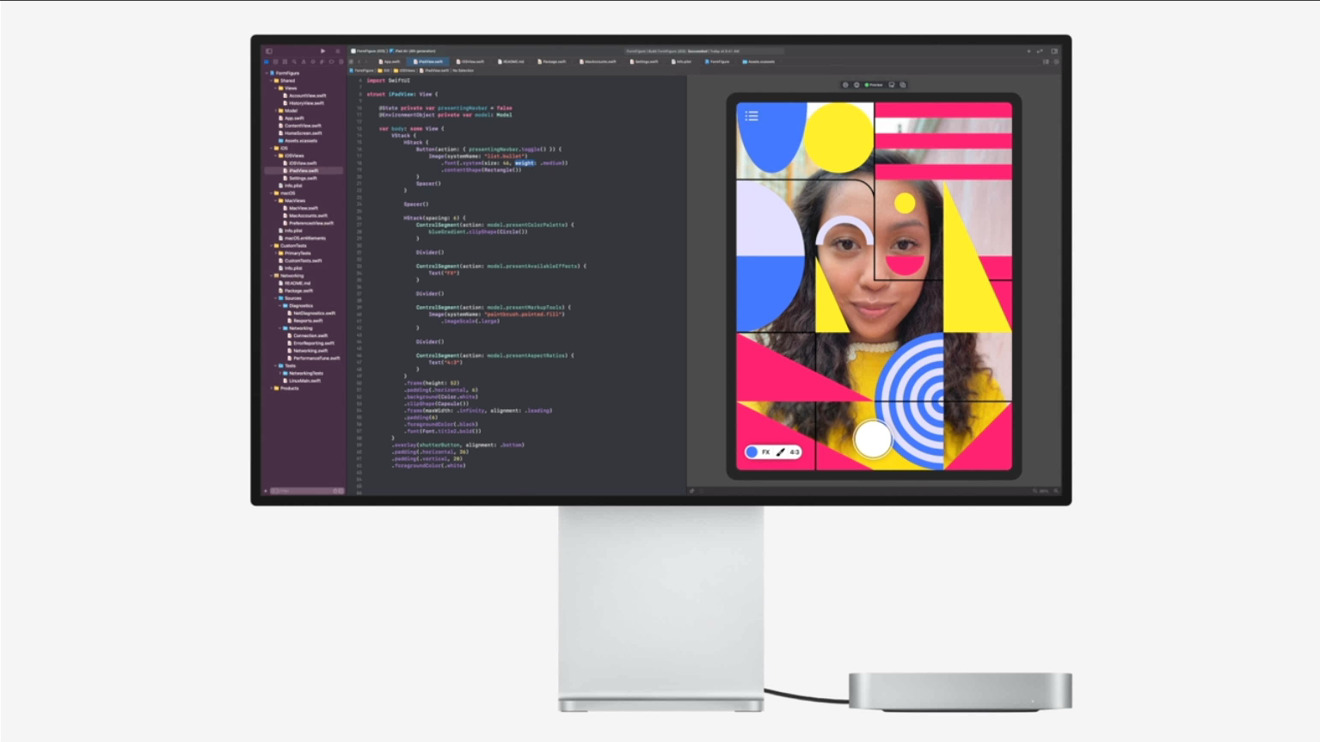
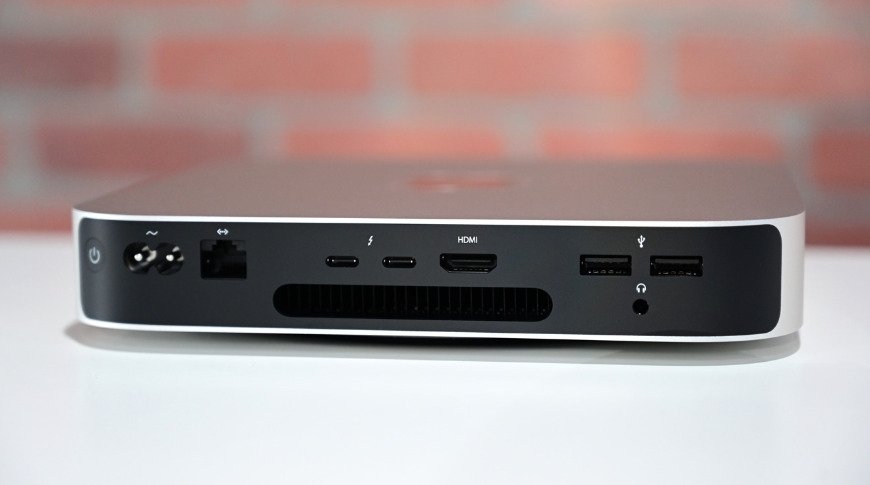
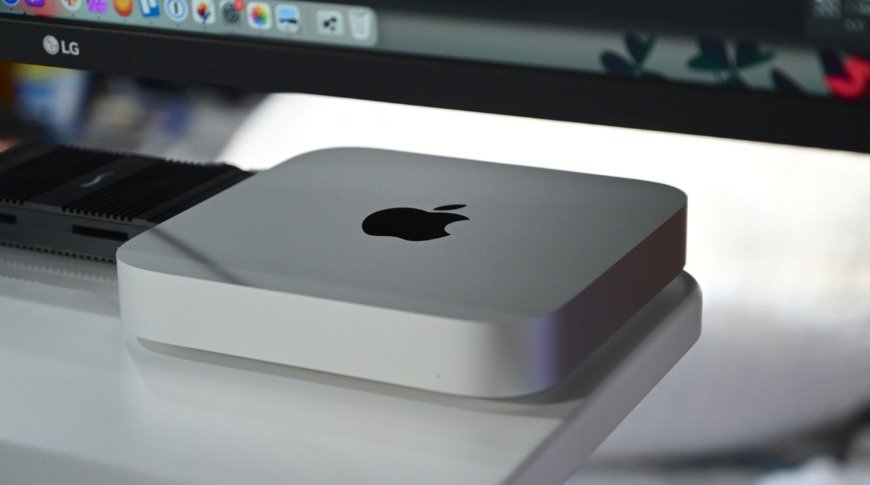







-m.jpg)






 William Gallagher
William Gallagher
 Andrew Orr
Andrew Orr

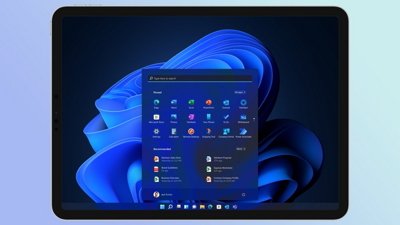

 Wesley Hilliard
Wesley Hilliard

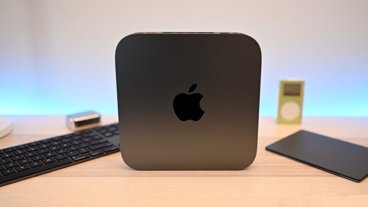

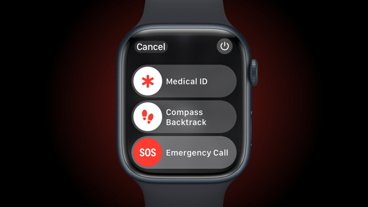


-m.jpg)




48 Comments
One thing not addressed yet is display connectivity. The M1 Mac mini says that is supports up to a 6K/60 display over TB, and a 4K/60 over HDMI. However, as someone with a pair of 4K TB monitors, I can't use the HDMI port and would have to use the TB ports. In the past, the 6K/60 limitation was due to bandwidth limitations of TB3, but if these are TB4, and the GPU so upgraded, then I'm hoping that it will support dual TB 4K displays, otherwise I can't use any oft he M1 devices (both laptops only support a single external display).
In fact, this article should probably be updated to note that the external display support has gone down a little, especially when comparing the laptops (my 2019 MBP supports dual 4K/60 and the built in display all at once).
But but but the haters said Apple is greedy and won't lower prices!
I'd like to see actual benchmark results, especially for graphics performance, including against a mac mini with an egpu with a reasonable card in it, like a vega64 or something. Saying the integrated graphics are 6 times faster than the previous intel one is fine, but that isn't a particularly high bar when you're removing any option of more powerful gpu technology which the previous one had. The new integrated gpu is competing (from a performance perspective) against the fastest gpu you could get in an egpu box that was supported by the previous model. I doubt the new model is actually faster than that, but it may well be fast enough to beat a moderate egpu setup, and without the expense, meaning a win for Apple. Or maybe it isn't and people will wait longer to upgrade until performance catches up to what they're leaving behind. Or switch platforms.
"
Unified memory was invented and named by Nvidia - back in 2013 - and is a widely known and used technology. So their options for calling it something else were a bit constrained.